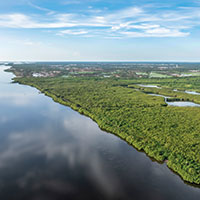 Big community north of Grand Harbor approved
Big community north of Grand Harbor approved
STORY BY STEVEN M. THOMAS (Week of August 15, 2024)
An innovative subdivision north of Grand Harbor that will have a population larger than most incorporated towns and cities in the U.S. just took a giant stride toward groundbreaking.
On July 25, a slightly bemused but mostly enthusiastic Indian River County Planning and Zoning Commission voted unanimously to approve the preliminary site plan for Spoonbill Preserve, which will include 460 single-family homes and 412 multifamily units, along with three clubhouses, a small neighborhood shopping center and extensive open space.
“I have to say, Steve, this is beautiful. I love the idea,” commission member Robert Votaw told project engineer Stephen Moler shortly before the vote, after Moler successfully fielded dozens of questions about the project.
The questions and bemusement were understandable. The board had never before approved a project like Spoonbill Preserve.
Spread across nearly a square mile between U.S. 1 and the Indian River Lagoon, stretching from Antilles in the north to Grand Harbor in the south, the development will have lots of unique and interesting features, including a provision allowing residents of Antilles to pass through the gated community to get to 53rd Street and Indian River Boulevard without traversing the busy federal highway.
But what makes the plan jump off the page is the dual nature of the development, which is both a subdivision and a major water purification system, with the built environment and natural world artistically integrated into a harmonious whole.
The new community will be built around “a manmade, biologically diverse saltwater wetland system that meanders throughout the project site in a serpentine manner,” according to county documents.
Seen from above, it looks like a Chinese dragon, with homes built around the perimeter and on elevated peninsula formed by the folds of the waterway.
Besides handling stormwater and lawn runoff from the subdivision’s nearly 900 residences, the undulating marsh will capture and purify runoff from Hawk’s Nest Golf Course and industrial sites on the west side of U.S. 1. It will also clean up millions of gallons of lagoon water daily, removing more than 12 tons of nitrogen and 9,000 pounds of phosphorous from the river annually.
“It is going to be huge,” Moler said of the waterway. “It will be 11,400 feet (more than two miles) long and 280 feet wide, which is almost the length of a football field.”
Four pumps capable of pumping 12,000 gallons a minute will pull river water into a settling pond that will overflow into a second pond that will overflow into the top of the marsh system. Multiply 12,000 by the number of minutes in 24 hours and it amounts to 17,280,000 gallons of lagoon water that will be stripped of harmful chemicals each day. That is 121 million gallons a week or 6.3 billion gallons a year at maximum capacity.
Sections of rubble will alternate with sections of marsh plants in the shallow, curving waterway. The rubble sections will function as settling ponds while the marsh plants absorb nutrients – nitrogen and phosphorous – that harm the river by feeding algae blooms.
Algae blooms cloud the water and kill seagrass, leading to the death of fish and marine mammals such as manatees and bottlenose dolphins.
The harmful chemicals come mainly from fertilizers and human waste leaking from faulty septic systems.
Spoonbill Preserve is a planned development, a technical designation that gives the developer more leeway with project design in return for providing some type and degree of public benefit.
“The water purification system is the primary public benefit of this project and has been sort of the backbone of the project since the conceptual phase,” Ryan Sweeney, county assistant planning & development services director, told the planning and zoning board. “The whole marketing end is to provide a greater good for the river.”
“It will have a lot of appeal for a lot of people,” said Berkshire Hathaway realtor Chip Landers, who voted to approve the plan as an alternate member of the PZC. “It’s a very interesting project with a lot of environmental enhancements that will be good for the public and boost ecotourism.”
Spoonbill Preserve will be built next to namesake Spoonbill Marsh, a county-run wetland area that treats briny wastewater from a reverse osmosis drinking water plant.
The Spoonbill Preserve project area is 413 acres. Spoonbill Marsh is another 67 acres. Both tracts are owned by the subdivision’s developer, Grand Harbor Land North, which leases the marshland to the county.
The two projects can be seen as a single, environmentally astute whole, which is enhanced by neighboring properties. There is another small wetland on the shore of the lagoon south of the county marsh, which the serpentine subdivision waterway will flow into. That is bordered by land owned by the Indian River Farms Water Control District at the outflow of its main north relief canal, which forms the southern boundary of Spoonbill Preserve, separating it from Grand Harbor.
North of Spoonbill Marsh is a 60-acre tract of undeveloped riverfront land owned by the Indian River Land Trust. So, the new homes and condos where approximately 2,200 people will live if Florida’s statistical average of 2.6 people per household prevails, will be set amid a green and watery world.
Spoonbill Marsh is open to the public by appointment and there is an existing boardwalk system for visitors. Grand Harbor Land North will add another 4,000 feet of boardwalk, extending deep into the mangroves, and enhance public access.
The history Spoonbill Preserve goes back more than 20 years to 2002, when an agent of Grand Harbor Land North began buying up the parcels that now comprise the subdivision site.
In 2004, Grand Harbor Land North purchased the accumulated 413 acres for $16 million from Scott Richey, who put the tract together.
It might seem strange that a big developer would decide to use so much land and incur so much expense for an ecological project feature that doesn’t directly bring in revenue the way more houses would. But developers do something similar all the time when they build communities around golf courses that eat up lots of acres but add value to the surrounding homes.
“We didn’t need another golf course,” Chris Cleary told Vero Beach 32963. “The property sits adjacent to an endangered water body and along a major relief canal, so the solution seemed obvious.”
Cleary, who was in charge of land development for Grand Harbor Land North when the project was conceived, said the developer is creating waterfront lots with the curving marsh, always a valuable commodity. People whose homes back up to one of the unplanted sections of the waterway will be looking out over a sparkling expanse of flowing water the size of a football field when they barbecue in the back yard on a sunny day. Those adjacent to the planted sections will enjoy fresh green views enhanced by waterbirds and other wildlife.
Landers noted that the developer was obligated to provide significant public benefit to get a planned development approved.
“The county staff is good at negotiating extras from developers,” he said. “At the same time, it enhances the community,” making it attractive to eco-minded buyers. “It is a win-win for everyone.”
Developers earn bad reputations when they clearcut and flatten out a piece of natural land to build cookie-cutter subdivisions, but the best developers steer clear of that approach these days, aiming to create communities that are not just profitable but purposeful and important.
On the Irvine Ranch in Orange County, California, which is known worldwide as an archetype of enlightened urban planning, the Irvine Company preserved almost 60 percent of its 93,000-acre master-planned project as natural wilderness and recreation space. That amounts to 57,000 acres in a place where land is now worth millions of dollars an acre – partly because of the company’s environmental stewardship.
The Irvine Company’s investment in public and ecological good greatly enhanced the value of the neighborhoods and commercial properties built in Newport Beach, Irvine and other cities on the ranch.
It also helped make company president Don Bren not just one of the top 10 environmentalists in the world, according to the Sunday Times, but “the wealthiest real estate baron” on earth in 2024, according to Forbes, which pegged his fortune at $18 billion.
Locally, the better angels of development can be seen in communities like DiVosta’s Waterway Village, where avenues are landscaped like botanical gardens, and GHO Homes’ Seaglass subdivision on the barrier island, where hundreds of mature oak trees were preserved at great effort and expense to create a charming, Old Florida, residential enclave.
At Spoonbill Preserve, where the county requires 31 acres of recreational space, the developer is providing 109 acres. Altogether, including the water-cleansing marsh, 209 acres, slightly more than half of the subdivision tract, will be devoted to open space.
The long delay in the project progress can be attributed in part to the 2007 real estate crash and Great Recession that stopped most developers in their tracks.
Things finally got rolling five years ago. In July 2019, the county commission approved rezoning the tract from low density residential to planned development, clearing a path for a project that is unique not just in Indian River County but probably in the entire state.
Not long after that, though, the pandemic threw another wrench in the works for developers, with supply chain problems, labor shortages and lots of scary unknowns.
Now things seem to be back on track.
The next step in the process is a land development permit, and Sweeney said the developer “is probably going to proceed directly to LDP,” applying for a permit to begin infrastructure work.
To get the permit, Grand Harbor Land North will have to provide more detailed construction and engineering drawings for the first phase of the three-phase project and clean up some legal loose ends, deeding rights-of-way parcels to the county and depositing funds for road building in an escrow account.
As part of the first phase, the developer will extend 63rd street, which ends now at the south entrance of Antilles, and build a north-south road connecting 63rd Street with 53rd Street, engineering a bridge over the north relief canal and essentially extending Indian River Boulevard to 63rd.
The first phase will also include “the project-wide innovative stormwater treatment system . . . and neighborhood commercial development,” along with houses and condos, according to county documents.
Rowland Bates, CEO of IE HCR (Homes, Clubs and Resorts), which owns Grand Harbor Land North, was present at the PZC meeting where the project got preliminary approval but did not indicate when he expects to break ground.
Landers thinks the project will have regional impact. “It enhances protection for the river, which is big nowadays,” he said.
“It is an exciting real estate opportunity,” Cleary said.



